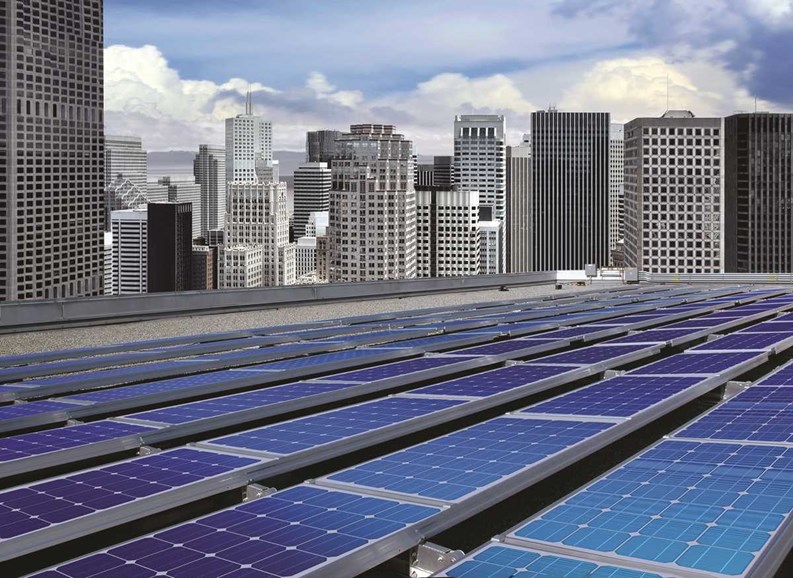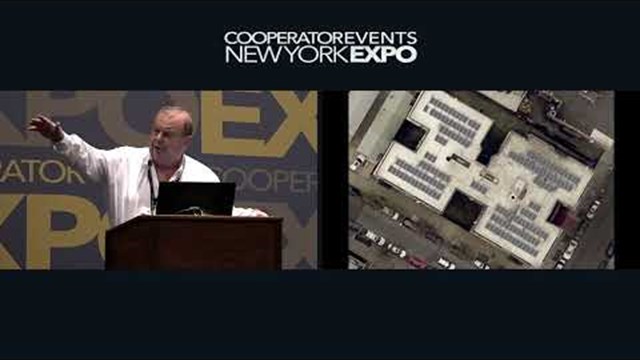As fuel prices continue to climb, consumers—including real estate developers and building administrators—are looking for alternative ways to power their buildings while saving money. Solar power is one possible option for such consumers, but issues of practicality and expense have made it a stretch when it comes to workable energy alternatives.
It’s been almost 40 years since Jimmy Carter famously installed solar panels at the White House, hoping to lead by example. The 30 years that followed saw no decline in the steep price tag of solar technology. But the last ten have been different. The incentives for converting to solar thermal are not just about the environment anymore, but economic in nature. And now Carter isn't the only politician pushing for solar technology.
Sunshine City
Governor Andrew M. Cuomo announced the NY-Sun initiative in 2012, with hopes of it increasing solar photovoltaic (PV) installations in New York. According to The NY-Sun initiative's website, the program enlists help from the New York State Energy Research and Development Authority (NYSERDA), the former LIPA (now owned by PSEG Long Island), and the New York Power Authority (NYPA), to ensure a coordinated, well-funded solar energy expansion plan. The current solar program is investing $800 million through 2015.
“The long-term commitment to solar energy represented by NY-Sun will make New York State a leader nationally in solar development,” Cuomo said of the initiative in his State of the State address last January. Cuomo also proposed an extension of annual funding through 2023.
The most prominent product of New York's push for solar expansion can be found atop a grocery wholesaler in Hunts Point in South Bronx. The project, which is the largest in New York City's history, houses 4,760 solar panels atop its roof. According to the New York Daily News, the panels are set to generate almost 2 million kilowatt hours of clean energy annually.
Solar Basics
“Solar usually has a great potential for buildings. Solar is free energy and you can benefit a lot from it,” says Madhuri Jannumahanthi, a green building analyst for the Bronx-based Association for Energy Affordability, Inc. (AEA). “There's PV and solar thermal. Solar thermal is amazing for tapping the energy for hot water, which is the major source of consumption for heating energy.”
The great majority of buildings that are equipped with solar are retrofitted, says Susanne Fischer-Quinn, head of corporate communications for Mage Solar USA (a global alternative energy company with offices and installations in nearly two dozen countries). “Since there are extremely reliable mounting options available (high wind resistance, low ballasted, and even non-perforating), this ‘retrofit solar option’ is actually also a good way to protect the current roof structure,” she says.
In other words, the solar panels on the roof serve more than one function.
“Solar is extremely flexible, scalable, has no moving parts and zero emissions. If a specific roof is not a practical option (e.g. due to shading, roof orientation) a ground mount, canopy, awning or tracker might be a sensible solution,” says Fischer-Quinn.
Solar power is not absolute, however. Just as a car that runs on vegetable oil requires some diesel fuel to make it work, backup energy sources are required.
“Some owners chose a battery backup system to be independent of grid outages. Besides greatly reduced (or in some cases even eliminated) energy costs, solar owners support the grid with clean, 100 percent renewable energy that is available every day of the year (except, of course, on extremely cloudy days),” says Fischer-Quinn.
Installations...and Limitations
The first step in installing a solar panel system is to determine the needs of the building, as well as its space restrictions. says Grant Salmon, a senior energy consultant at Steven Winter Associates in New York City.
“The biggest limiting factor in residential is just the availability of enough square footage to mount the panels—the first thing you need is the real estate for it,” he says. “You need to have a roof that you can actually have the space to mount a meaningful amount of solar on. If you don't have a big enough roof area or the roof is being used for another purpose, you're not going to have enough space to mount enough panels to really make a difference. A lot of condo and co-op buildings have amenity spaces up on the roof level and that can certainly compete with space for the solar you're looking to install,” Salmon says.
Despite space restrictions, there are other options as far as installation goes, logistically speaking. “We have seen more innovative ground mount type of displays that are becoming more popular where they're actually using the solar panels to create some shielding from the weather,” Salmon says. “We see these over parking lots a lot, where they will fill up the structure and the solar panels make up the roof of the structure and people park their cars underneath that. So that's a potential option up on the roof of a residential building if they're looking to have a shady spot where the residents can hang out in the summertime.”
Consider This...
Sure, it's admirable for an association to strive for the implementation any type of renewable energy in their building, but solar tech isn't a perfect fit for everyone. There are several considerations a building should consider prior to making the financial leap toward solar tech investment. This is why the pros suggest associations should hire a consultant to perform a feasibility report that will weigh the pros and cons of installation, ultimately deciding if the investment will be worth it.
Whether solar is a part of construction plans for a new building or it's done as a retrofit project, a building's surroundings must be considered, says Gina Buffone, director of new construction at AEA.
“If it's new construction, you want to orient the building accordingly, but you rarely have that option in New York City. Also, you have to consider what surrounds you because there are shading factors. You also have to consider what is going to happen in the future. You don't want to put in a beautiful solar array and then have somebody come and block it with a taller building 10 years down the line.”
A building's existing electrical infrastructure should also be taken into account, as it might lead to extra costs in the retrofit process, Salmon says.
“Once you start pulling permits for things like solar, then that might trigger the need to modernize more electrical systems in the building, so it would certainly be advantageous for an owner to work with a solar consultant to really get a feasibility study to get a precise idea of exactly what systems would need to be upgraded. It could add to the cost of the project if you have to end up pulling all new wires through a building or something like that,” he says.
Safety in terms of roof access should also be a prime concern, according to Adam Romano, AEA’s director of training operations.
“If there is an incident where the fire department needs to get on the roof if there is a fire in the building, there is sometimes a bit of hazard that can be developed, so I know that there are some setbacks that follow. That's why it's really important to have someone come through and assess the site for feasibility because when there is an existing building, the roof needs to be able to support the wind load and the structures,” he says.
Maintenance poses a separate challenge, Jannumahanthi adds.
“One of the main concerns is maintenance. You want to have the solar panels cleaned and at times it might be hard to get access to them to clean them. If you don't have really clean panels the efficiency drops and you don't get as much energy as you should be getting,” she says.
From Going Green to Saving Green
Solar probably costs less than you think. The start-up costs have gone way down. “The prices for solar modules alone have dropped 70 to 80 percent in the last three to four years, making reliable solar technology available more than ever before,” says Fischer-Quinn. “There are also attractive ‘starter options’ available, for example, plug-and-play technology AC modules that are installed in less time (almost 50 percent faster), reducing the overall cost of the install.”
So what are the benefits of solar power? The green ones are obvious. Energy from the sun is much cleaner than electricity from a power plant. But there’s more to it than that.
“It’s clean, renewable energy at a lower cost than most utilities will charge,” says Fischer-Quinn. “Many homeowners are also attracted by the benefit of being independent from rate spikes and by locking in to a long-term energy rate for up to three decades.”
And of course, the cost savings are a big bonus. “You can offset probably 10 to 15 percent of the total electrical [costs] of the building,” Salmon says. The owner-paid electrical expenses in the building would certainly be slashed. “You do have the potential to sell electricity back to the power companies so that's the way a building can improve the economics of what they're looking at.”
Solar power is also a useful sales tool and can increase the marketing appeal of a particular building.
“There's certainly something of a resiliency angle there too, because a building that does have on-site renewables certainly has an improved chance of keeping the lights during some sort of prolonged service disruption—that's certainly a benefit people are considering now more than they used to in the pre-Hurricane Sandy days,” Salmon says.
The ROI
In terms of return benefits, there are an array (pun intended) of incentives available to consumers.
“There's a 30 percent federal tax credit that most buildings capitalize on,” Salmon says. “Another financial tool buildings use is called accelerated depreciation, where they can write off the cost of the panels in an accelerated time frame on their taxes.”
Other available incentives include the New York City property tax abatement, which will cover 10 percent of system costs after rebate, divided over four years and capped at $62,500 annually, or the amount of real property taxes owed during a year. The residential New York State income tax credit provides 25 percent of the after-rebate cost in a credit up to a maximum of $5,000. NYSERDA on the other hand also offers a $1.40/watt rebate, up to a maximum of 7 killowatts.
“All of these things kind of add up and knock the price of the entire project down close to 50 percent, and that's making the economics more affordable than it ever has been. It certainly is making things more appealing,” Salmon says.
Holistic Energy
“Anytime you're looking to add any renewables to a building, whether it be solar thermal, PV, wind, whatever it may be, the first step is always energy reduction,” Romano says. “Being able to reduce the existing load will help maximize your return. You have to look at it holistically to have the maximum benefit.”
Salmon agrees, adding, “Something that we've always said is you think about doing solar on a building after you've done almost everything else. After you've sealed the building up, minimized infiltration, after you've insulated the building properly and addressed the inefficiencies in the boiler plants and the heating and cooling plants.
“The economics are becoming such that you want to be evaluating solar as part of your evaluation of other energy conservation opportunities—this is from a retrofit standpoint. It certainly used to be that the economics of solar probably weren't as good as the economics of replacing a really inefficient boiler plant. But with the different subsidies you can kind of stack together these days, solar is certainly a cost-effective measure and one that should be considered during the feasibility stage of an energy conservation project a building might be planning,” he says.
Despite a number of challenges to a solar installation, especially in the energy landscape that is New York City, solar energy is one option worth considering even in existing co-ops and condos.
Enjolie Esteve is an editorial assistant at The Cooperator. Greg Olear, a freelance writer and a frequent contributor to The Cooperator, contributed to this article.







Leave a Comment